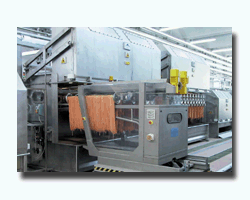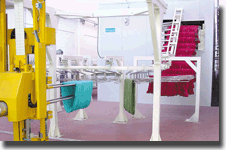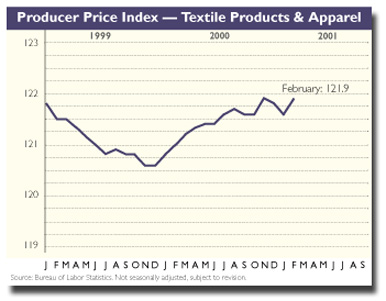High-end knitting yarns are very popular, provided they fully match the exacting specifications of
top-quality products. With increasing reliance on technology to set the textile industries of
developed nations apart from low-cost competition, companies are constantly searching for the
capability to excel at difficult production techniques. One such opportunity exists through lap
dyeing on star-frame machines from Obem and Maibo in Italy. These machines are completely automated
and robotized and can provide a plant with outstanding performance, including significant benefits
in operational economy and production flexibility. But first, it is necessary to explore the
background of what has precipitated this nearly insatiable thirst for automation and technology by
industries in developed countries. The Art Of DifficultyAt every season change, new
trend-setting collections are presented at Frances Pitti Filati. These collections feature the
latest in product composition, structure, count, color, finishes and end-uses for knit and woven
goods. At times, it has seemed the intent of the designers and creatives has been decidedly
sadistic, as they render creations seemingly aimed at making life difficult beyond all measure for
manufacturers. Flashes of design brilliance, along with extreme performance properties required by
the designs, have at times taxed technical capabilities to the limits. But, of course, like so many
things, these high-performance properties and difficult-to-manufacture fabrics are part of a subtle
strategic move aimed at leveling the playing field with low-cost manufacturers from the Far East
and other regions. With these high-end products, the market favors the professionals in Europe and
America who can call upon experience, expertise, financial resources, skilled personnel and the
best production plants available in the globalized textile world.By hook or by crook, we have
become real masters of this art of difficulty, said one Italian entrepreneur, whose family woolen
mill has operated for more than a century in the top end of the sector. In substance, in order to
rise to the present and future challenges, it is wise to carve out for oneself a sustainable niche
in the upper part of the market pyramid. To be successful, one should express to the utmost the
best qualities of a companys potential and transmute them into excellent products, superior
efficiency and a wide range of versatile customer services.In order to carry out a synergistic
action in these areas, industrials in Italy, for example, are mustering not only the resources of
textile manufacturers, but of machine and plant builders as well, to provide the newest tools for
the production of the enhanced technical and qualitative properties and characteristics that take
various materials beyond state-of-the-art. Italian textile specialists have recognized the need of
having domestic industry at the forefront of the specialized machinery field. Textile manufacturers
and machinery producers are working closely together on the development of new machines and
innovative process technologies that maximize the advantageous differential in production
capability between low-cost countries and the Italian industry.A concrete example of the synergy is
provided by Botto Poala, which has aggressively adopted automated skein dyeing of delicate yarns on
star-frame machines by the lap-dye method. Quality FirstFounded in 1876 by Botto Giuseppe,
what is now the Botto Group embodies four companies, of which Botto Poala and Cascami Seta are the
most influential in relation to lap dyeing. Though the groups businesses are dominated by wool, the
existence of a silk-processing business unit speaks volumes about the technical/commercial layout
of the industrial holding company, which is located at Vallemosso. It is an indication of a trend
toward high-quality products (it is not by chance that silk is still the queen of fibers) and
diversity of yarn offerings in the marketplace. The company produces not only fine and very fine
wool, cashmere, luxury hair and blends thereof, but also silk, silk blends, fine cottons, linens
and even man-made fibers capable of imparting particular properties and functionality (microfibers,
elastane) to special yarns.All of these products and more were on the stand of Botto Poala at Pitti
Filati during the launch of the Fall/Winter 2001/2002 collections. Quality first is what we are
looking for, said Roby Botto Poala, the companys chief executive. We concentrate our efforts on
quality; on service, which is increasingly important; on heavy investments in the dyehouse that
substantially improve service; on delivery management. The mastering of the pipeline from
combing/spinning to dyeing ensures the full control of the product chain. The customer requirements
are ever-increasing, and we fall into line accordingly.Of particular interest to TI was the TMB/CNM
hank-dyeing machine from Obem and Maibo, which debuted at the Paris ITMA. This machine requires no
human handling of material, except for hanging the greige hanks for the final unloading of the dyed
material from the dryer. The First PhaseBotto Poalas new dyehouse has been completely rebuilt
on the site of the previous installation. Some work was still underway at the time of the
interview. Before long, an automatic color kitchen will be installed, and then well start operating
on two shifts, said Fabrizio Roncarolo, plant manager. For the time being, we have a long working
day and produce 1000 to 1200 kilograms (kg). Ultimate production capacity is about double the
current output. Today, we handle an average of 25 batches a day, with three operators in the
department and five specialists in the laboratory, where about 100 daily dyeing tests are carried
out. The dominant role is played by the first phase of production, which is the study of what is
necessary for the reproduction of the reference samples supplied by customers, and for the
preliminary control performed on the already dissolved recipe ready to be added to the dyebath for
the production. It is an indispensable precaution in our situation, and for two definite
reasons.

The first is that the customers demands are very high (tantamount to zero tolerance) and,
therefore, the execution must be perfect, as far as humanly possible; and, secondly, with the kind
of materials usually processed (extremely delicate luxury yarns), it is virtually impossible to
resort to redyeing, which would affect the final quality. Consequently, for us, right first time is
not a beautiful definition, but an absolute processing imperative. Always to the end of achieving
the highest quality of dyed yarns, we chose the star-frame machines, which handle the skeins
without subjecting them to the wearing action of an intense dyebath circulation, as is required
with standard cabinet dyeing machines. On the other hand, in the past, these machines were
penalizing, as they involved a substantial labor need and downtimes for drops and lifts.Today, with
the machines you are seeing here, the lot changeover takes place in a matter of a couple of
minutes. Moreover, the fact that the wet material is never touched during processing is an
additional great advantage of genuinely qualitative type.In addition, mention should be made of the
matchless versatility of this type of equipment with regard to flexibility and dyeable quantities.
We must produce batches weighing from 4 to 5 kg up to 200 to 300 kg, and this is easily performed
on the 10 ranges installed. Moreover, these can be coupled for dyeing one batch only. Although we
are always working under pressure to ensure on-time deliveries (on average, they take place about
15 days after the order), this plant has performed as expected for more than six months. We have
less than 2 percent of lots that need redyeing.The plant also features a highly advanced laboratory
(the heart of the system for a plant of this kind), and produces fabric in an atmosphere of high
environmental quality. Robotization In DyeingObem has been a name that in Italy is synonymous
with innovative solutions and intensive, steady research in automation of package, tow and top
dyeing. Its robotized API-O and API-V lines feature both high productivity and efficient operating
economy. These ranges have been installed all over the world (20 API-O and nine API-V lines).The
challenge recently taken up by Obem and its subsidiary, Maibo, targets a virtually untapped field
in which there has been little robotization hank dyeing.Many difficulties have so far prevented a
rational evolution in this field. First and foremost is the hank suppleness, which makes every
handling step extremely critical in comparison with the similar operation carried out with cheeses
or other firm packages.

More than a year of development and experimentation on scale models, combined with the
experience made available by the Botto Group, have led to the development of the worlds first fully
robotized hank-dyeing plant, which is installed at the new dyehouse of the Filatura Botto Poala.
Skein handling is carried out by an automatic shuttle, called CNM-4B (a smaller version of the
well-known CNR-10 P model). Obems solution consists of handling skeins already loaded on their
carriers in order to reduce the number of handlings inside the dyeing machine, and in the modular
loading concept of typical package dyeing machines. The shuttle can transport up to four dyeing
arms (with a minimum module equal to two arms), which it then loads into the TMB-SV/tr
apparatus.The latest version of the star-frame machine, which features triangular arms and is
manufactured by Maibo, is a boon to high-end yarn producers because of its extremely delicate yarn
treatment. The extractable arms make this machine well-suited to robotization; furthermore, the
arms permit the production of partial loads by loading blind or half blind arms.The installation is
particularly rational and ergonomic. The only phase the operator must take care of is the manual
loading of the hanks on the arms and their removal at the end of the treatment. These operations
take place at two distinct stations, which are located at the ends of the plant for easy control of
incoming and outgoing material.The Minnetti company contributed, together with Obem and Maibo, to
the development of the new range by providing the squeezer, which is equipped with a manipulator
for the withdrawal of the dyed hanks from an interchange station, as well as from the chain oven
from which the skeins come out uniformly dry and ready for shipment. The TMB-SV/tr machines with
triangular rotating arms are made in various sizes, with a capacity ranging between 10 and 300 kg
per machine and, in the case of machines linked in parallel, with the possibility of loads up to
600 kg per batch.The basic point of difference for this machine is its triangular skein holder,
which can rotate around itself. In this fashion, the arm ensures both the liquor passage to the
yarn, and the hank rotation (according to times pre-established by the user). Consequently, there
is no lap arm, a component that is a mainstay of conventional equipment. This expedient eliminates
dry friction and yarn tangling, thereby enhancing the final quality. With the 1.2-meter-long
version (20-percent longer than conventional arms), each arm has a capacity of from 8 to about 15
kg of yarn, depending on reeling and on the type of fiber employed.At the new dyehouse of Botto
Poala, Lessona, there are 10 machines with variable capacities and configurations: two arms (from 4
to 30 kg of material); eight arms (from 24 to 100 kg); and 12 arms (from 72 to 180 kg). Visual
Dye: The “Made In Obem” ProgrammerThree years have elapsed since the launch of VisualDye, the Obem
software program that operates on PCs that have the Windows 95 or higher operating system. With
more than 100 units installed, the technology represents for Obem a further step forward in the
pursuit of value-added customer service. A color touch screen enables all machine functions. As
well, VisualDye can handle up to 400 different dyeing programs and can obtain in real time all
information relating to the dyeing equipment, which makes this product an ideal user interface for
the Obem dyeing machines.Developed by the companys in-house research and development department,
this programmer features an industrial PC, which is continually updated. The network card
integrated into the PC enables VisualDye to communicate, via the customer Ethernet network, with
the centralized dyehouse controller: the VisualDye Center.From the server of the VisualDye Center
office, the program controls up to 60 dyeing ranges, receiving in real time all necessary data to
process a complete report for each production cycle. It is possible to remotely activate the
machines manual controls in order to create and implement dyeing cycles and to print all
information necessary for the efficient running of the department. In robotized dyehouses,
VisualDye communicates directly with the operating software of the material transport (also
designed by Obem). Finally, upon request, it is possible to interface connection with the
best-known color-kitchen controllers, as well as software for complete dyeing management. Because
the operating software is easily customized to different production requirements, the VisualDye
Center can integrate pre-existing dyeing machines that have not been built by Obem.
April 2001







